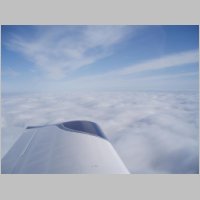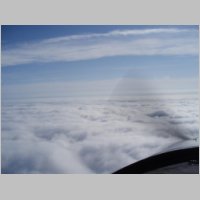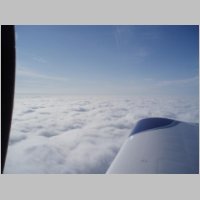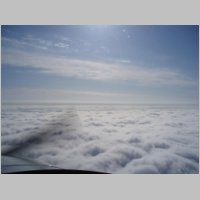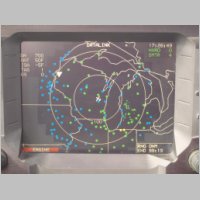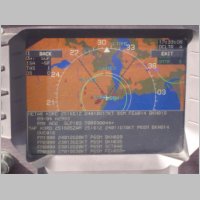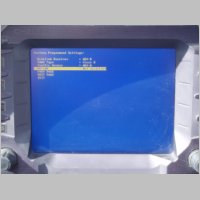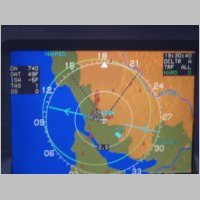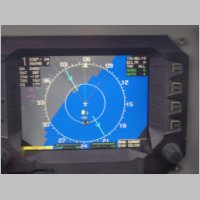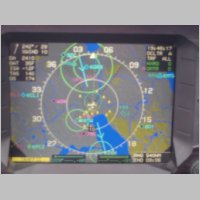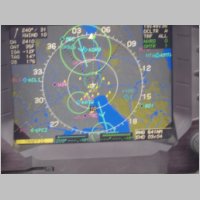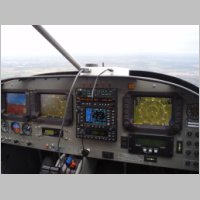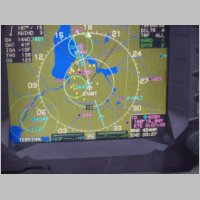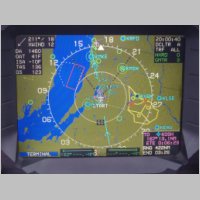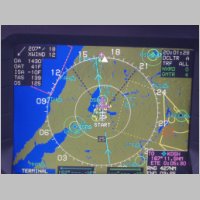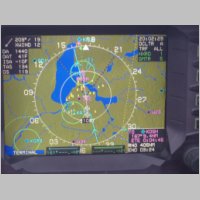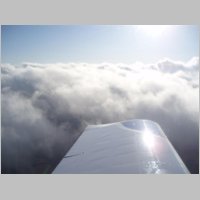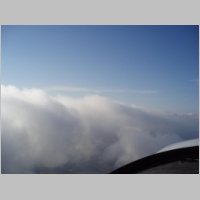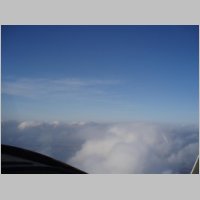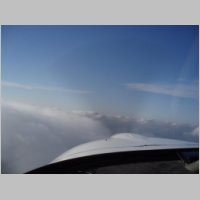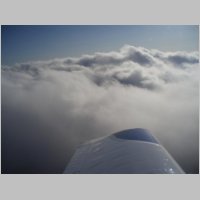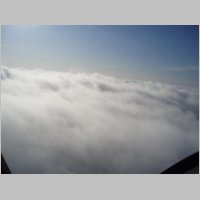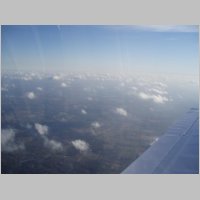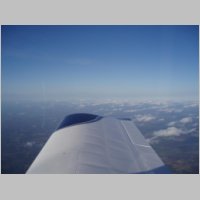NavWorX ADS- B Testing in N104CD
Added 10/26/2008This year at OSH 2008, if you wandered all the big vendor hangars like I did, you may have run across a new company called NavWorX. They were a little bit harder to find than some, not in the "big 4" center hangars, but up nearer to the flightline, in I believe it was called Hangar E, the same one where TCW Technologies was showing off their Safety-Trim and other new products. NavWorX is a new producer (founded in 2007 but working on their products for a few years prior) of ADS-B transceivers for the GA market. I myself walked by them quickly, and saw their transceiver on display, and it grabbed my attention enough for a stop. Turns out they were interested in getting hooked up with the various EFIS manufacturers to ensure that their product integrated into lots of systems. As you may or may not know, before this, your ADS-B choices were basically limited to Garmin....the monopolizing giant in the market, and as with most things garmin, all the technology was proprietary....you buy one garmin product and you may end up buying ALL garmin if you wanted it to work with all the peripherals. But here was a new company producing a new ADS-B transciever (and a portable receiver-only) for FAR less (many thousands) than Garmin's offering. So I wrote down my EFIS of choice (Chelton) on their list of customer-requested vendor integrations, and went on my way. NavWorX by the way is not at all affiliated with WxWorX, an XM satellite weather provider.
Surprise surprise, a few months later on the Chelton EFIS forum that I started, one of the NavWorX people, Bill Moffitt, joined in to announce that he was going to be working on integrating their system into the Chelton EFIS. I offered my assistance, and as anyone who knows me knows, I love interfacing and wiring things, and I love digging in and understanding how it all works on a deeper level, so this was a great opportunity. A little less than a month later, Bill was coming up near this part of the country, so we decided to hook up and see what we could accomplish. It may be easy, or it may take work, but we had to do some wiring and testing to find out.
Before I go to far into what we did, let me put up some links to ADS-B information:
ADS-B Coverage areas
ADS-B Wikipedia Page
FAA's ADS-B Fact Sheet
So how did it go? Well, it was, in short, a smashing success! I prepared the plane by building a couple of wiring harnesses that I could insert inline into my existing TIS Traffic system (the GTX-330) and my existing Wx system (WSI), and use these harnesses to replace those services with the NavWorX ADS-B system....and to analyze the signals, if necessary, from the other systems. In the end though, it was much simpler than I imagined, as NavWorX really has their system prepared. One other HUGE help is that Chelton already has all of the ADS-B capabilities in their system as well. Chelton was involved in the Capstone project in Alaska, and they used ADS-B up there as part of that project, so it is one of the very few systems that is already ready for ADS-B today. To get it going, all it took was one simple harness connection, and 2 line changes on my EFIS. For the future, with a permanent mount system, I'll add a couple of additional wires so that I can provide my accurate Baro Corrected altitude to the system, or the WAAS GPS signal from my GNS-480, to provide a more accurate altitude to transmit via the ASD-B Transmitter. But the wiring itself is very minimal to get it all operational. It was great having Bill right there to work with, as it gave me a better understanding of the capabilities and function, and he knew right away the various technical things that we'd have to do to make it all work and talk correctly. One note about the systems...the PADS600 (and ADS600) is a receiver-only UAT, but NavWorX will also be offering a transceiver that does the transmit portion of the ADS-B also. There may also be a split-mode senario in that some users may opt to upgrade their GTX-330 transponder to the 1090 ES standard to meet the mandate for ADS-B out.
From NavWorX:
1. The PADS600 is a portable
ADS-B receiver-only product (comes with
USB and Garmin 396/496 connectors, bluetooth optional, separate dc jack
for power) - (This is what we used for this page of photos, although it
was a prototype with
different connector)
2. The ADS600 is a non-portable ADS-B receiver-only product (comes with DB37 low density connector containing various interfaces - RS232 for ADS-B data in/out, RS422 for GPS timemark signal for external WAAS GPS navigator connection (eliminates the need to use our internal GPS, and hence having to connect a separate GPS antenna. optional ARINC 429 interface for connecting to devices that display ARINC 735 TCAS traffic (e.g. Garmin 430/530, GNS480).
3. The ADS600-T is the transceiver. Due to be certified by the end of 2009.
"We plan on certifying both the receiver and transceiver. For now, we will be selling un-certified ADS600 and PADS600 until that time. If one purchases any product (cert or un-cert) from us before the certified transceiver comes available, they can upgrade for cost difference plus shipping. That's our plan for now. I have to say for legal reasons that we reserve the right to change any thing I've mentioned above, at any time (mainly because if the FAA finalizes the NPRM and it contains something drastic that would change our cost structure, we'd have to pass that along."
2. The ADS600 is a non-portable ADS-B receiver-only product (comes with DB37 low density connector containing various interfaces - RS232 for ADS-B data in/out, RS422 for GPS timemark signal for external WAAS GPS navigator connection (eliminates the need to use our internal GPS, and hence having to connect a separate GPS antenna. optional ARINC 429 interface for connecting to devices that display ARINC 735 TCAS traffic (e.g. Garmin 430/530, GNS480).
3. The ADS600-T is the transceiver. Due to be certified by the end of 2009.
"We plan on certifying both the receiver and transceiver. For now, we will be selling un-certified ADS600 and PADS600 until that time. If one purchases any product (cert or un-cert) from us before the certified transceiver comes available, they can upgrade for cost difference plus shipping. That's our plan for now. I have to say for legal reasons that we reserve the right to change any thing I've mentioned above, at any time (mainly because if the FAA finalizes the NPRM and it contains something drastic that would change our cost structure, we'd have to pass that along."
